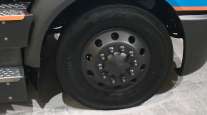Makers Blame Materials Costs, Demand for Rising Tire Prices
This story appears in the Jan. 16 print edition of Transport Topics.
Tire manufacturers say that an ongoing shortage of component materials — which is expected to continue through 2012 and beyond — combined with soaring global demand and logistics costs, has driven up costs and led the makers to boost prices for commercial tires.
Prices for “natural rubber and, later, synthetic rubbers, increased to unprecedented levels during 2010 and 2011. They have gone up . . . [to] levels which are still unprecedented in modern history,” said Walter Weller, vice president of China Manufacturers Alliance, Monrovia, Calif., which makes Double Coin tires.
“At the same time, steel, carbon black and oil have all increased continuously — not to mention transportation costs,” Weller explained in an e-mail. “The tire industry —right, wrong or indifferent — chose to implement increases in stages over this period of time and, for some manufacturers, more increases are needed, which is why you continue to see them.”
He added: “I would say that the more recent increases are probably a reflection of oil/carbon black/steel price increases than natural rubber.”
In addition to Double Coin, other manufacturers that raised prices include Goodyear Tire & Rubber Co., Akron, Ohio; Bridgestone Americas, Nashville, Tenn.; Yokohama Tire, Fullerton, Calif.; Continental Tire the Americas, Fort Mill, S.C.; and Toyo Tire USA, Cypress, Calif.
Michelin North America Inc. and Hankook Tire America Corp. did not respond to requests for comment by the time this story went to press.
“We see supply being short of demand for the near term — for sure, the next one to two years,” said Donn Kramer, Goodyear’s director of product marketing.
Kramer said that on Nov. 1, Goodyear raised U.S. prices on all brands of commercial tires, retreads and tread rubber by up to 10%.
And although Bloomberg News recently reported that the price of natural rubber has dropped by approximately 50% from its high in February 2011, Keith Price, Goodyear’s director of national media relations, said, “Most tire manufacturers use first-in, first-out accounting, [which results in about] a two-quarter lag on raw material costs on finances.”
“Say we’re buying natural rubber today and it’s lower than it was six months ago; it’s going to take five, six months for that to show up in our product cost,” he said.
Price described what typically happens from the time the natural rubber is purchased to the time the tire is sold and Goodyear receives its money: We “buy natural rubber from Thailand, it comes over on a boat to New Orleans, it’s loaded onto a truck and transported to the Goodyear plant in Danville, Va., where it is put into raw material inventory. [Then] it is made into a tire, which is put into a warehouse until it’s bought, the purchaser is invoiced and the money comes in. That whole process takes about two quarters.”
Goodyear makes commercial tires in Danville, Va.; Buffalo, N.Y.; and Topeka, Kan., Price said.
“The commercial-tire industry as a whole saw significant price increases across the board on nearly all products in 2011,” said Chris Ripani, director of marketing, strategic brands and channels, for Bridgestone Commercial Solutions, a unit of Bridgestone Americas. “Bridgestone has raised prices in line with the rest of the industry.”
Ripani added, “When you compare 2010 to 2011, raw material prices rose significantly, including the price of natural rubber. The cost of raw materials represents more than 50% of the overall cost of a tire. It is important to keep in mind that when raw material prices increase, it not only impacts a significant portion of the direct cost of the tire but also the costs associated with making the tire.”
On Jan. 3, Yokohama announced that it was raising prices on its commercial tires by as much as 8% on Feb. 1.
“Manufacturing and logistics costs associated with commercial products, unfortunately, have continued to be at high levels,” Rick Phillips, Yokohama’s director of commercial sales, said in a press release. “These, along with domestic and global economic pressures, have made initiating the price increase unavoidable.”
In a previous interview, Phillips told Transport Topics, “Raw material costs have been too extreme for us to absorb internally, so over the course of 2011, we had no choice but to pass these along in the form of price increases. The supply-and-demand imbalance still exists, [and] we think it will go at least through 2012 and possibly into 2013.”
Phillips added that higher demand from growing economies abroad and original equipment manufacturers in the United States also will “put pressure on the replacement market.” And he noted Yokohama has had to deal with increases in “transportation, insurance, labor and related expenses.”
And Clif Armstrong, director of marketing for Continental, said, “We buy rubber from commodity brokers. Our prices went through the roof the last 18 months. . . . We couldn’t make up for the cost increase in efficiencies and volume.”
Armstrong said that, although rubber prices have come down, “the price of natural rubber today is still much higher than it was two, three years ago.”
Also citing market conditions such as limited production and tight supply, Armstrong said, “Natural rubber prices appear likely to return — that is, increase — to levels they were at in early 2011.”
He added, “Another factor affecting another material [is] a major manufacturer of carbon black dropped out of the business two or three years ago. Since then, supply has been tight.”
Armstrong said natural rubber can account for approximately 40% of the content of a Continental commercial tire.
Rubber industry executives, trade groups and tire manufacturers cite adverse weather in Asia during 2010 for the rubber shortage, Bloomberg News reported, saying that drought and heavy rain made tree-tapping difficult, resulting in a supply lag that is expected to continue through most of 2012, possibly longer.
About a dozen countries account for most of the global production of natural rubber, the Association of Natural Rubber Producing Countries said on its website. The inter-governmental organization, based in Malaysia, includes Cambodia, China, India, Indonesia, Malaysia, Thailand and Vietnam. Its members accounted for about 92% of global production of natural rubber during 2010, the association said.
In the United States, the growth of demand for tires surged with new-truck sales, manufacturers said. In the first 11 months of 2011, OEMs and their dealers sold 150,419 Class 8 trucks, up from 95,410 in the same period in 2010, reported WardsAuto.com (TT, 12-19/26, p. 1).
And, as one would expect, fleet managers are noticing the sharp increases.
“We are paying substantially more for all tires,” said Wayne Finchum, maintenance vice president for Titan Transfer, Shelbyville, Tenn., a carrier with 320 tractors and more than 800 dry van trailers. “I am seeing an estimated 17% to 25% increase, depending on brand.”
J.A. Bates, owner of J&P Trucking, Ider, Ala., estimated that tire prices for his fleet of 100 trailers and 44 tractors increased “between 10% and 15%, at least,” in the latter half of 2011.
Tire manufacturers say they have taken steps to counter the price increases and fleets’ operating costs. These steps include the development of low-rolling-resistance tires, which improve fuel efficiency and are SmartWay certified, said Gary Hendricks, truck sales manager for Toyo Tire.
SmartWay is a public-private partnership between the U.S. Environmental Protection Agency and the freight transportation industry designed to help shippers, carriers, and logistics companies improve fuel efficiency and save money.
Likewise, Goodyear is marketing its DuraSeal, a self-sealing technology, and Fuel Max Technology, in which design and compounded materials combine to provide a low-rolling-resistance tire that improves fuel miles per gallon, Kramer said.
Phillips told TT that Yokohama offers a line of tires called “Zenvironment.” The casings of these tires will carry a seven-year unlimited retread warranty, he said.
Some tire makers whose products are at the higher end of the price scale said fleet users should focus on the cost of operation, not the purchase cost. However, some tire makers whose products carry lower prices said the cost of operation of their products is competitive with the higher-priced products.
Aaron Murphy, a vice president of Double Coin tires manufacturer CMA, said more fleets now “review or evaluate alternative products or brands . . . that in the past they may not have considered. Many find that these [brands] allow for an equal or lower cost per mile.”
Bates of J&P Trucking said he uses lower-priced Double Coin tires in conjunction with Meritor Tire Inflation Systems by P.S.I., San Antonio, which makes a tire pressure maintenance system that he is phasing into his fleet. This decision enables him to get a cost of operation that is competitive with higher-priced tires, he said.
In addition, some fleets are using retread tires in applications for which they previously were not used.
Titan Transfer’s Finchum said the carrier began testing retread drive tires in 2011. Up to that point, the carrier never had used retread tires at the drive position, he said.
“It’s just a matter of getting the best bang for the buck,” Finchum said.




